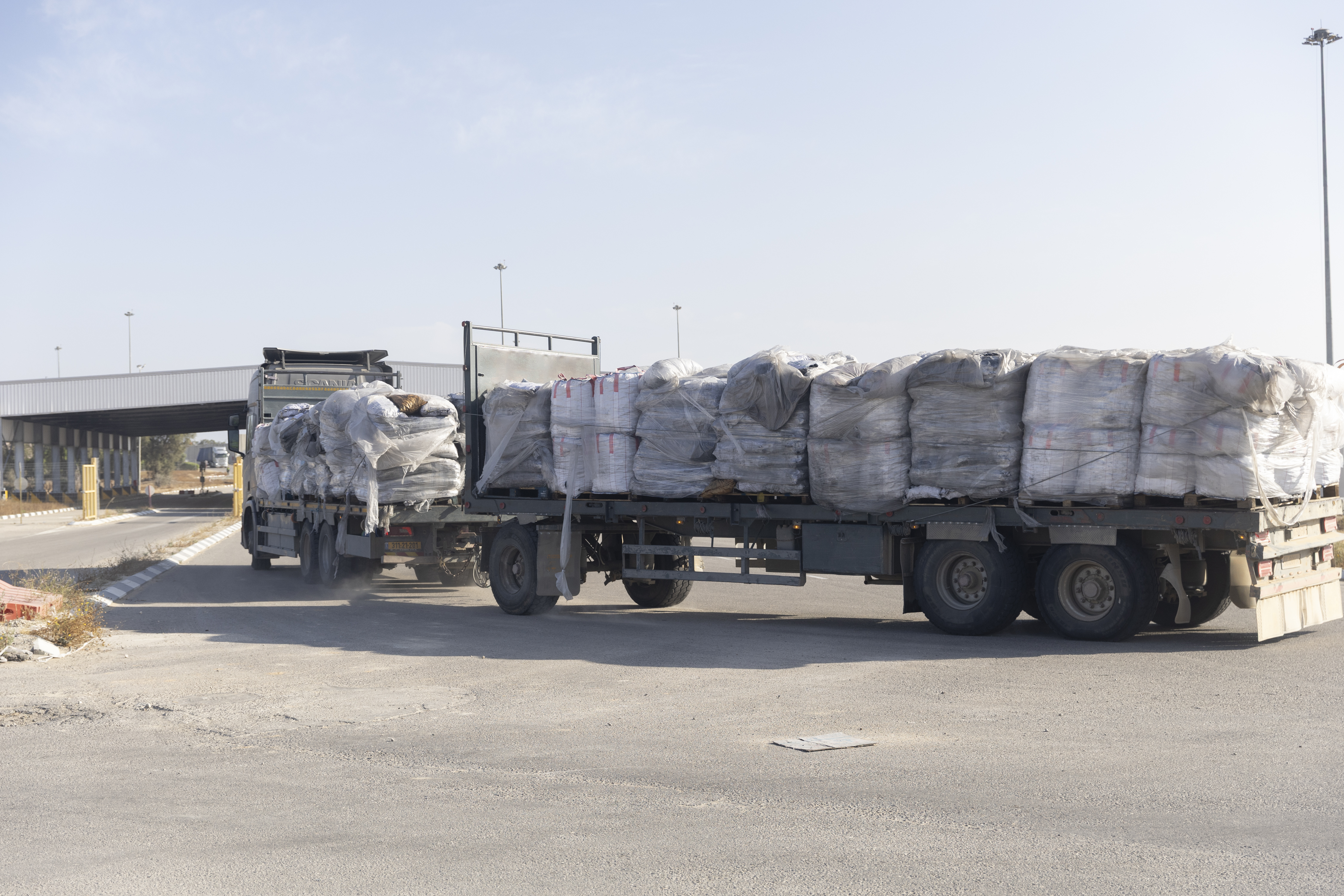Early Tuesday morning, while workers with the Gaza Soup Kitchen prepared to serve meals for displaced families sheltering at a United Nations school in Mashrou’ Beit Lehia, Israel’s bombs began to fall.
For 30 minutes, Israeli military munitions and quadcopter gunfire rained down on a city block in northern Gaza, which included the U.N.-run Khalifa school, a market, and residential buildings, said mobile kitchen director Hani Almadhoun, relaying an account from his nephew, a kitchen staff member who survived the attack. Dozens scrambled for shelter from an airstrike that left at least four people dead.
Among them was Almadhoun’s 16-year-old cousin, Samih Ibrahim Almadhoun, who had been volunteering at the kitchen. He was killed alongside two women sheltering together, Almadhoun said. Another cousin helping at the kitchen had his arm amputated after he was struck by rocket fire. Mourners were able to bury Samih in a hastily dug grave before fleeing the area.
The strike forced the kitchen out of Mashrou’ Beit Lehia and further south into Jabalia. Such movement is normal for the kitchen, which operates several mobile sites throughout the Strip and relocates to wherever need is most acute. “We go where the people are,” Almadhoun said. Some families have come to rely on the Gaza Soup Kitchen as their primary source of food amid the ongoing starvation brought on by Israel’s unlawful blockade of humanitarian aid to Gaza. But as of late, where the kitchen goes is dictated by bombings and evacuation orders.
In November, Almadhoun’s brother, Gaza Soup Kitchen co-founder Mahmoud Almadhoun, was killed in an Israeli drone strike while delivering food to Kamal Adwan Hospital, which had been under siege by the Israeli military. Almadhoun and his family have called the attack a targeted assassination, and said the military continues to target soup kitchen workers.
“We learned that if they bomb and they are serious, then we get the hell out,” he said. “We tried to be the last man standing, then we realized the world doesn’t give a shit. So, when they really push, we just run for the next area where they’re going to bomb in a week or two.”
This is the reality in Gaza: Death can come from the lack of food, or death can come from trying to find food.
Tuesday’s airstrike near the soup kitchen in Mashrou’ Beit Lehia was a part of a broader Israeli military a campaign launched last Sunday known as “Operation Gideon’s Chariots.” It involves intense bombardment in the north intended to push Palestinians further south, eventually concentrating Gaza’s population of about 2.1 million people into what Israeli Prime Minister Benjamin Netanyahu called a “sterile zone,” completely controlled by the Israeli military. The Israeli government has also used the term “sterile zone” in the occupied West Bank to refer to areas that isolate Palestinians while giving access to Israeli settlers. The zone would be the only place in the Strip where Palestinians could receive food and aid supplies. Aid would be funneled into four distribution sites, with three in southern Gaza run by a new Swiss-based nonprofit and two U.S.-based security firms.
Both Israel and the U.S. claim the aid plan is meant to keep supplies from getting in the hands of Hamas, which they accuse of stealing goods and enriching themselves in the black market, an allegation denied by both Hamas and aid groups.
Earlier this month at a Jewish settler conference, Israeli Finance Minister Bezalel Smotrich, a member of Netanyahu’s far-right cabinet who has long called for the establishment of Jewish settlements in Gaza, previewed the plan to push Palestinians to the south, referring to southern Gaza as “a humanitarian zone” along its border with Egypt. From the south, he said according to translations from Hebrew, Palestinians “will start to leave in great numbers to third countries” due to poor living conditions.
The southern Gaza area where Israel intends to push Palestinians has been under Israeli occupation since late March, when its military forced civilians out of the area’s largest city, Rafah. Though much of Rafah already lay in ruins from previous bombing campaigns, the Israeli military has been destroying what few structures remain. During its occupation, Israel established the Morag Corridor — a new road named for a former Israeli settlement in Gaza — that cuts off southern Gaza from the rest of the Strip. While Netanyahu has said the security corridor is intended to root out Hamas militants, officials have also been vocal about their intent to erase Palestinian civilians.
“They will be totally despairing,” Smotrich said of Palestinians during the pro-settler conference, “understanding that there is no hope and nothing to look for in Gaza, and will be looking for relocation to begin a new life in other places.”
When discussing Operation Gideon’s Chariots, Netanyahu on Wednesday echoed his right-wing ally, telling reporters that among his conditions “to end the war” is the demand that Hamas disarms and is exiled from Gaza. He also said that Israel will “carry out the Trump plan,” likely referring to President Donald Trump’s proposal to turn Gaza into “the Riviera of the Middle East” and relocate its Palestinian residents to neighboring countries — a premise aligned with the long-held vision of far-right settler groups in Israel. NBC News recently reported that the Trump administration had been working on a plan to permanently displace as many as 1 million Palestinians from Gaza to Libya, which has its own issues of instability and violence, and is known to mistreat migrants. Though U.S. Secretary of State Marco Rubio said he was not aware of the Libya plan, he repeated Trump’s plan of displacing Palestinians to other third-party nations.
Netanyahu credited Trump’s proposal on Wednesday as “a plan that is so correct and so revolutionary.”
To Almadhoun, it’s obvious what comes next.
“This is the final stage of ethnic cleansing,” he said.
On top of his work with Gaza Food Kitchen, Almadhoun heads philanthropy efforts for the U.S. wing of the United Nations Relief and Works Agency for Palestine Refugees in the Near East, or UNRWA, which manages most of the direct aid to Palestinians. Almadhoun is based in Virginia, but much of his family — including his mother, siblings, nieces, and nephews — live in Gaza. Along with the brother killed in the hospital attack, another brother was killed alongside his family by an Israeli airstrike in their home in early 2024. Almadhoun said he fears his remaining family will be forced south under the plan, into a humanitarian zone that he calls an “internment camp.”
“Our family will hold on to Gaza as long as we can,” he said, “but I fear I’m going to lose another person that I care deeply about.”
Israel’s plan to control dispersal of aid has drawn wide condemnation from Palestinians, human rights organizations, aid groups, and the United Nations, which are responsible for the majority of aid distribution in Gaza.
A little-known Swiss-based organization, the Gaza Humanitarian Foundation, or GHF, is slated to lead Israel’s U.S.-backed aid plan for Palestinians displaced to southern Gaza. The organization was run by former U.S. Marine sniper Jake Wood, who received recognition for his disaster relief work in Haiti, for two months. Wood announced that he had resigned from GHF on Sunday, stating that the foundation would not be able to adhere “to the humanitarian principles of humanity, neutrality, impartiality, and independence, which I will not abandon.”
GHF was founded in February and has already received a reported $100 million from a foreign government donor, prompting questions about the sources of its funding. The foundation is expected to manage the distribution of aid in the designated sites, with security administered by two American private security firms: Safe Reach Solutions, based in Wyoming, and UG Solutions, based in North Carolina, which are reportedly staffed by former CIA, Blackwater and U.S. military personnel. Armed contractors with the firms previously ran checkpoints along the Netzarim Corridor during the ceasefire earlier this year as Palestinians returned north. There have been reports that the security firms would use facial recognition on Palestinians seeking aid, which Wood has dismissed as “misinformation.” The aid plan is set to take effect in late May, Netanyahu has said, with the Israeli military providing limited security support.
The U.N. typically operates 400 distribution sites; the Israeli plan would trim that down to four.
Aid groups and the United Nations have rejected the plan, which circumvents humanitarian guidelines and the existing structures in place to deliver aid to Palestinians in Gaza. Lacking buy-in from the U.N. would mean the more than 13,000 UNRWA aid workers in Gaza would be sidelined. The U.N. typically operates 400 distribution sites; the Israeli plan would trim that down to four. UNICEF spokesperson James Elder said the plan leaves Palestinians with “impossible choice between displacement and death.”
Scott Paul, Oxfam America’s director of peace and security, dismissed the aid plan for forcing Palestinians to “reshuffle their lives and dramatically shift where they’re living in service of political agenda.”
“It’s a plan that would inevitably leave behind hundreds of thousands, if not more than a million Palestinians, many of whom would be the most vulnerable and endangered people in the Gaza strip,” Paul said. He added that the Gaza Humanitarian Foundation’s plan leaves “meaningful assistance as an afterthought” and doesn’t address other necessary aid, such as clinical health services, outpatient health services, shelter needs, waste management, and access to clean water.
“Mostly what we’re talking about is the desire to avoid the appearance of complicity in a famine,” Paul said.
Mara Kronenfeld, executive director of UNRWA USA, likened the plan to the concentration camps of Nazi Germany that her grandfather fled and where his sister and her family were later killed.
“Putting the same country that is out-loud threatening extermination and has already transformed most of Gaza into rubble, and then actively pushing people out,” Kronenfeld said, “putting that entity in charge of humanitarian aid to keep people alive is just flat-out a combination of laughable and evil.”
Before his resignation as GHF’s director, even Wood acknowledged that the foundation lacks the capacity and infrastructure to deliver aid on its own and had requested that traditional aid groups be allowed to deliver non-food aid, according to a leaked letter he sent to the Israeli government, published by The Associated Press.
A spokesperson for the Gaza Humanitarian Foundation told The Intercept in an emailed statement that the group is “independent and apolitical” and “will never participate in or support any form of forced relocation of civilians.” While there will initially be four distribution sites — three in southern Gaza and one in central Gaza — the GHF spokesperson said there will be “no limit on the amount of sites the GHF could open” and plans to open more in the north. The spokesperson said GHF hopes the U.N. and other aid groups would start to work with them through the new system, though it is unknown if the foundation received permission from the Israeli government amid the military’s ongoing campaign in the Strip.
“While there were benefits to the previous UN-led mechanism — in terms of networks and capacity — the reality is that the previous UN-led mechanism is no longer viable because of the concerns around diversion of aid,” GHF said in the statement, referring to worries of looting and allegations that aid is being diverted to Hamas to be resold in the black market.
The foundation did not provide evidence to substantiate the claim of aid being diverted to Hamas, which the Israeli government has made in the past to justify blockades on Gaza.
Once aid is delivered to civilians, however, aid groups cannot control ends up in the black market, said UNRWA USA’s Kronenfeld.
“There are always ways for groups like Hamas or others to be able to access [aid], but you cannot hold an entire civilian population without food in an effort to try to isolate a small tiny percent of the population,” said Yousef Munayyer, a senior fellow at the Arab Center Washington, D.C., this week, while speaking on a virtual panel with Kronenfeld. “This clearly amounts to collective punishment. It is absolutely illegal under international law.”
The Israeli government has blocked or limited aid shipments into Gaza as a means of military and political strategy since 2007 when it laid siege on the territory, crippling its economy. It has done the same at multiple points in its current invasion. Its most recent and most brutal effort to restrict humanitarian aid started in March and had lasted more than 80 days, the longest of the conflict, before Israel last Monday began to allow some supplies into Gaza. Amid the unlawful blockade, food and other essential supplies — such as fuel, water, hygiene products, medicine, and medical supplies — have grown increasingly scarce.
With the majority of aid still out of reach from Palestinians in need, aid organizations told The Intercept that Israel’s blockade largely remains in effect.
Even Netanyahu this week admitted he only allowed the “minimal” amounts of aid to maintain support from international allies. He said U.S. senators had threatened to withdraw support of Israel if they continued to see “pictures of … mass starvation.”
The Israeli government approved about 100 trucks of aid to enter Gaza this week, with the first loads of flour and baby formula reaching storehouses and bakeries on Thursday. The number of trucks is far below the amount seen during the brief ceasefire earlier this year, when about 600 trucks per day arrived. Even that figure, aid groups said, was inadequate to address the humanitarian crisis.
The new shipments have been confined to a single crossing in southern Gaza, Karem Shalom, rather than utilizing the handful of entry points open during other parts of the war. Aid officials have also blamed the Israeli government for delays and burdensome inspections that have further slowed aid.
“All the aid authorized until now amounts to a teaspoon of aid when a flood of assistance is required,” said U.N. Secretary-General António Guterres on Friday.

Photo: Amir Levy/Getty Images
One in 5 Palestinians in Gaza face starvation, according to an Integrated Food Security Phase Classification report released last week, and the entire Strip is currently at risk of famine. This famine risk includes nearly 11,000 pregnant women, and nearly 17,000 pregnant and breastfeeding women are expected to need treatment for acute malnutrition in the next 11 weeks. More than 9,000 children have already been treated for acute malnutrition this year. Over the past week, 29 children and elderly have suffered starvation-related deaths, Gaza health officials said.
Trump has yet to comment on Israel’s latest offensive and aid plan, but his Cabinet members have expressed support. During a congressional hearing on Tuesday, Rubio said he was “pleased” with Israel for allowing some aid into Gaza. The flow of military aid from the U.S. to Israel has also accelerated under Trump.
In a recent interview with NPR, U.S. Ambassador to Israel Mike Huckabee defended Smotrich’s calls to destroy what remains of Gaza, arguing that the Israeli official was referring to “the culture that was created by Hamas.” Huckabee claimed that Hamas had circumvented aid money meant for boosting Gaza’s economy to “build bombs and bullets and tunnels.” He went on to question why the U.N. rejected the U.S.-backed aid plan for Gaza “if you really care about the food getting to people.” Huckabee also downplayed speculation that Netanyahu has fallen out of favor with Trump, who notably snubbed Israel during his visit to the Middle East last week.
While ceasefire talks continue in Doha, including reported direct talks between the U.S. and Hamas, Israel has shown no sign of slowing its offensive.
By Wednesday, the Israeli military said it had struck at least 800 targets inside the territory since it launched its new operation on Sunday, aimed at “terrorist cells.” Strikes have continued to destroy civilian infrastructure and kill scores of Palestinian civilians, including a week-old infant who died Wednesday from blast wounds in a central Gaza hospital. At least 629 Palestinians have been killed by Israeli military strikes in the past week; 358 of them, including 148 children and women, were killed inside their homes or tents, according to the U.N. Human Rights Office in Occupied Palestinian Territory. Among those killed are nine journalists, marking this week as one of the most deadly for journalists in Gaza since the attack by Hamas on October 7, the U.N. office said.
On Thursday, the Israeli military announced further evacuation orders for large swaths of northern Gaza, including Beit Lehia and the Jabalia refugee camp, as the military promised to strike the area “with great force.” The evacuation orders affect thousands of refugees sheltering in the area — and will likely again force the Gaza Soup Kitchen to relocate.
For some, meals from the Gaza Soup Kitchen are their only source of food for the day. The mobile kitchens feed roughly 360 families daily, said Almadhoun. In recent weeks, lines have gotten longer and people have grown more aggressive, Almadhoun said, as supplies run thinner and food prices skyrocket — with a bag of flour selling for as much as $500. But the constant bombardments have hampered their ability to provide aid.
On Sunday, when a farmer helped drive Almadhoun’s mother out of Beit Lehia to flee Israel’s bombardment, Almadhoun’s family gave the man two packs of food in thanks. Hours later while the driver lay asleep at home, an Israeli strike killed him, his wife, their children, and extended family — 10 in all, Almadhoun said.
Several weeks ago at one of the mobile kitchens in northern Gaza, while dozens of people lined up for food, Israeli bombs fell a couple blocks away. Those in line begged the kitchen to serve them their meals half-cooked. “‘We just want to take it and stay alive,’” the crowd told kitchen workers.
“There is no point in freely giving food to people,” Almadhoun said, “and then have them only die by Israeli bombs the next day — that’s the reality.”
Update: May 27, 2025
This story has been updated to include new information on Jake Wood’s resignation from the Gaza Humanitarian Foundation.




